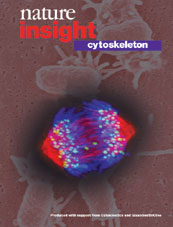![]()
Cytoskeleton
Vol.
422, No. 6933 (17 April 2003).
|![]() PDF
PDF![]() (187
(187![]() K)
K)![]() |
|
 |
Cover
illustration |
The cytoskeleton of eukaryotic cells pervades the cytoplasm. It comprises three broad classes of proteins: actin filaments, microtubules and intermediate filaments. In addition to establishing cell and tissue shape, the cytoskeleton — along with associated motor proteins — influences a wide range of fundamental cellular functions, including cell migration, movement of organelles and cell division.
We are witnessing a rapid advance in our understanding of the cytoskeleton, driven in particular by determination of the structures of key molecules and acquisition of proteomics inventories of cytoskeletal proteins and their binding partners. The cytoskeleton is now no longer considered to be a rigid scaffold, but instead is viewed as a complex and dynamic network of protein filaments that can be modulated by internal and external cues.
This Insight examines many different facets of the cytoskeleton, reviewing the basic principles of filament organization, the operation of motor proteins and the role of the cytoskeleton in key biological processes. There is also consideration of the ways that pathogens subvert the cytoskeletal elements of the host cell to allow entry and spread of the invading organism. With this broad range of topics we aim to appeal not only to the cytoskeleton community, but also to the wide range of our readers who have an interest in cell biology.
Although significant progress has been made in understanding the cytoskeleton there is much still to be learnt. This Nature Insight, therefore, not only provides an overview of the current status of the field, but also provides perspectives on the directions of future research from leading scientists.
We are indebted to all the authors who contributed to the Insight and we apologize to those whose areas could not be covered owing to space restraints.
DEEPA NATH
Senior Editor
 | |||
| The
cytoskeleton, cellular motility and the reductionist agenda THOMAS D. POLLARD doi:10.1038/nature01598
| 741 | ||
 | |||
| Cell
division JONATHAN M. SCHOLEY, INGRID BRUST-MASCHER & ALEX MOGILNER doi:10.1038/nature01599
| 746 | ||
| Dynamics
and mechanics of the microtubule plus end JOE HOWARD AND ANTHONY A. HYMAN doi:10.1038/nature01600
| 753 | ||
| Molecular
motors MANFRED SCHLIWA AND GÜNTHER WOEHLKE doi:10.1038/nature01601
| 749 | ||
| Adaptation
of core mechanisms to generate cell polarity W. JAMES NELSON doi:10.1038/nature01602
| 766 | ||
| Microbial
pathogenesis and cytoskeletal function SAMANTHA GRUENHEID AND B. BRETT FINLAY doi:10.1038/nature01603
| 775 | ||
 | |||
| Leading
the way to the next generation of anti-mitotics KENNETH W. WOOD PH.D., JEFFREY R. JACKSON PH.D., DAVID J. MORGANS JR. PH.D., JOHN D. ELLIOTT PH.D., JAMES H. SABRY M.D. PH.D. & PEARL S. HUANG PH.D. doi:10.1038/422781a
| 781 | ||
| About
Cytokinetics doi:10.1038/422782a
| 782 | ||
| About
GlaxoSmithKline doi:10.1038/422783a
| 783 | ||